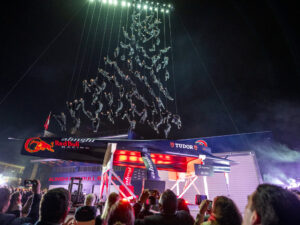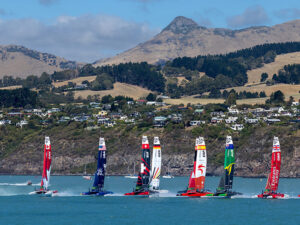Team Metropolitan to Team Vagabond
While most teams used the cars or vans they drove to the regatta to stash their dry clothes, lunch, and extra gear while they sailed in the 2000 America Trophy, MAISAs nationals qualifier, the Columbia University Sailing Team was forced to make do with a small patch of grass. As the result of a March 2000 school-wide moratorium, which prevented Columbia undergrads from driving themselves to any athletic event, we were a team without transport for the spring season.
A massive e-mail and phone campaign detailing our plight scored us a ride to the America Trophy, which was hosted by Old Dominion University in Norfolk, Va. The U.S. Merchant Marine Academy, a.k.a. Kings Point, and Princeton joined forces to get us to the regatta. Their generosity saved us from returning to Manhattan via a Greyhound redeye to take final exams, bleary from a lack of sleep and the intoxicating stench of the chemical toilet. We rewarded Kings Points kindness with PowerBars. Princeton received a 30-pack of Corona long necks. Sailors who witnessed that windfall immediately asked if we needed a ride home.
For shorter rides, we turned to cabs. Fortunately the Columbia University bureaucracy temporarily abandoned their traditionally tight-fisted ways and sponsored the team to the daily $35 taxi rides to and from our practice site on City Island, N.Y. Outside of New Yorks five boroughs, however, we found that even our newly anointed “Sugar Daddy” couldnt always help us out. Our first night in Norfolk, we waited for three hours for a golden chariot to ferry us home from Taco Jonnys. The next morning, reluctant to wait for a cab and unwilling to beg for another ride, we walked the mile from the Old Dominion Inn to the ODU Sailing Center. For me, however, the prospect of lugging my 30-pound gear bag forced me to swallow my pride long enough to find a ride for my luggage.
Once the preparatory signal sounds, however, it no longer matters how anyone got to the regatta. It wouldve been nice to qualify for nationals. But those rags-to-riches stories arent a common occurrence in the cutthroat MAISA division, where funding and performance are at least partially linked. We did finish a satisfying eighth in B division and 10th overall. And this fall, after I had transitioned from student to alumni, the team raised enough funds to hire a coach.
-Elizabeth Carroll
Ducking the Cold
The first day of snow this past fall in Burlington, Vt., was Oct. 22. It was also the first day we had to de-ice the boats before practice and the first day I was reminded why sailing in Vermont has always been a little insane.
The University of Vermont fall sailing season can be broken up into two parts. In the early fall we relish picturesque Lake Champlain and a steady 10 to 15 knots out of the northeast as we cling to the remnants of our summer tans. Around the time the first snow hits the ground, the prevailing breeze morphs into a shifty 15- to 20-knot southwester, drysuits replace shorts and bathing suits (there goes the tan), and lampreys-leeches masquerading as fish-rise from the depths of Lake Champlain and starting hitching rides on the bottom of our FJs.
Everyone who attends school in Burlington has their own way of dealing with the cold. Many people just spend more time indoors. The sailing team, forced to forego this option until the season ends in mid-November, has its own tricks. As the self-proclaimed wimp of the team, I have the most tricks. I put on my drysuit after the first frost and break out my ear muffs after the first snow. When the temperature really drops, I don my wardrobe of synthetic clothing.
But my favorite little trick for warding off the cold is the Duck Dance. Its done by locking your arms straight down by your side, holding your hands out at a ninety degree angle-parallel to the ground-and rapidly hunching your shoulders up and down. I always get funny looks, especially when I break this out at a particularly cold NEISA regatta. But there are usually a few sailors from some of the warmer districts whose frantic, and usually futile, efforts to avoid frostbite pull the spotlight off me.
It can be tough to motivate for practice when the snow starts flying, especially when you know that 1,000 miles to the south all the SAISA schools are probably still sailing in shorts and T-shirts. Yet theres a bright side to practicing in the snow. A good day of sailing in the snow leaves you with a great sense of accomplishment, not to mention a nice ruddy glow. Were one of the few teams that can celebrate the coming of winter with skiing and sailing in one day. And when you walk into class with a bag full of gear after an early-morning practice, well, its a great conversation starter.
Finally there are the great chance encounters that can take place when schools from the Great White North and the South mix at intersectional regattas. I overheard one such chat at a regatta in Boston last fall between a teammate of mine and a sailor from SAISA. It was snowing so the discussion quickly turned to the weather differences between New England and the South Atlantic states. After the conversation ended, the SAISA sailor walked away with a look of disbelief, amazed that in some parts of the country it snows in mid-October, and, yes, people sail in it and deal with it. What wouldve really perplexed him was to know we also enjoy it.
-Courtney Wilkinson
Trolling for Coaches
The Monday before the navy womens Fall Intersectional my sophomore year, our team captain introduced me to the Laser. She walked me down the beach, showed me how to rig the thing, and then left me to figure it out on Lake Michigan. By Wednesday, I had spent as much time swimming as I had sailing, but could at least tack without flipping. My teammates were supportive of my efforts. “You just have to move faster,” was a popular nugget of advice.
A gale ripped across the lake on Thursday, and I unsuccessfully begged the team not to make me go out. We started driving for the Naval Academy at dawn on Friday, and by Saturday I was on the line in C division racing against a fleet of women-all of whom seemed to know more than I did about sailing a Laser.
We had no coach at the time, so my pre-game pep talk consisted of “You see the girl in the red life jacket? Thats Alice Manard. Just follow her.” Needless to say, following Alice, an All-American from Stanford, involved staying upright downwind, and I had yet to master that skill.
“Try more vang!” a teammate yelled as I dumped again.
“I already did!” I screamed back once Id pulled myself from the water.
“Try less?”
Like many collegiate sailing teams, we never had the money or administrative support to hire a full-time coach-forcing us to fend for ourselves at regattas. However, during my four years at Northwestern, we always found a former collegiate All-American to at least help at practice and nationals, when we qualified. Believe it or not, good coaching exists in the strangest of places.
In our case, we usually found our coaches at either the Kellogg Business School or some other graduate program. Each fall, beginning in 1992, various sailing team members would stake out the graduate school dorms, student center, parking lots, and bars looking for that one sign: a college sailing hat, T-shirt, bumper sticker, or jacket. The person would then be besieged with promises of free beer and the chance to sail every afternoon. Of course, thered be no mention of whistle blowing, mark setting, chase-boat driving, or hypothermia until the person hit the water at least once. Usually, by the time they realized how cold it would be in March, we had them hooked. We never had a spring season with less than two days of coaching each week.
When we did lack for a volunteer coach, the team still practiced every day. At intersectionals, we made a concerted effort to meet other teams coaches, and on occasion they would keep an eye out for us as well. Soliciting advice from other teams might not have been ideal, but it at least answered a few questions and introduced us to a lot of people.
When you battle for four years against programs with coaching staffs and seemingly unlimited funding, its easy to feel like youre getting the short end of the stick. But since graduating, Ive worked with several different sailing teams, and I now realize that at Northwestern we learned as much without a coach as we did with one. Having no one to turn to, we had to coach ourselves. Not only did we figure out the fastest way to get around the marks, but we also learned how to bring the entire team up to speed. Funny, but good coaching really can come from the strangest places.
-Beth Holland
Canadas Best in Jest
After taking a semester off to train full-time in my Laser, I returned to Queens University in Kingston, Ontario, in the fall of 1999. To a certain extent, my learning curve had leveled out, and I felt participating in the college circuit would make me a better sailor. I also secretly savored the idea that maybe I could become the second All-American from Queens, and the first in 20 years. I practiced mostly in Lasers with teammates Bernard Luttmer and Nathan Cowan and competed almost exclusively in Laser events, but the 1999 MAISA Sloop Championship sparked our desire to team up.
We knew competing in a keelboat without practicing would be difficult, but since most schools are unable to train for the event and qualifying was done by resume, we felt wed have a shot at not only qualifying, but also doing well. Bernard was the 1998 Laser North American champ, I was a 1999 Pan Am Games gold medalist, and Nathan and Gordo (our fourth) were nationally ranked in the class. When we began to fill out the form, we realized we had a problem. It was divided into three sections: J/24 experience, collegiate sloop experience, and other sailing accomplishments. We packed the “other sailing accomplishments” section, but left the other two almost empty.
The form also wanted to know who was going to be where on the boat. None of us had any keelboat experience and the application deadline was the next day, so we wrote what came naturally: crows nest, jib cunningham, cook, and first mate.
A few weeks later we received the ranking results. We were ranked sixth out of seven teams and only the top five qualified for the MAISA Sloop Championship. We were disappointed, but I guess I wouldve axed four guys like us if I was a coach. This wasnt the first Queens screw-up and it wont be the last, but we learned from our mistakes, and the next year we put together a solid resume, complete with actual sailing positions-skipper, tactician, jib and spinnaker trimmer, and twings and foredeck. We won the 2000 MAISA Sloop Championship with the exact same team.
-Oskar Johansson
Lunch Run
The goal of every spring sailing season is to qualify for the dinghy nationals. The primary reason for this is obvious; why compete if you dont aspire to win. But there are some other great things about qualifying for the ICSA North American Championships besides racing in the actual regatta. Topping this list is practice week. Schools on semester schedules usually finish classes two weeks before the competition begins. This gives sailors time to sail and “prepare” for the regatta, without having to worry about schoolwork. During my four years at Boston University we were fortunate enough to qualify for the nationals each year. Each practice week created one or two special memories, but the one experience that really stands out happened my freshman year.
That year we practiced with Harvard, at their boathouse, but with our FJs. The particular practice I have in mind began just after 11 a.m. Harvard was still in class so we were alone for this mid-day training session. We were supposed to begin practice around 10 a.m., but something-it may have been the previous nights activities-kept the majority of the team from arriving on time.
It was a beautiful day on the Charles River. Shorts, shoes, and lifejackets were all we needed to go sailing. But there was one necessity we were missing, the wind. Fingers of breeze could be seen in some places on the Charles; in other spots the river was so smooth it perfectly mirrored the Boston skyline. It was, many of us thought, perfect weather for tanning. Our coach, Brad Churchill, had other ideas.
Were going to lunch, he said, at the Cambridgeside Galleria, a mall thats a short bike ride from the Harvard boathouse. But, he added, were going to sail there.
We roll tacked our way down the Charles to the Longfellow bridge, where we tipped our boats over and, holding onto the top of the mast, walked them under the bridge.
Once on the other side of the bridge, we were in uncharted territory. Brad led us into a small canal on the left side of the river. Occasionally a pedestrian would stop and stare at us, a man in a small powerboat blowing whistles at six boats that were jumping at every noise he made.
The small canal led us to a fountain pool, which is directly in front of the Cambridgeside Galleria. We arrived just around lunchtime, tethered our boats, and proceeded to the food court. Some of us were at the end of our food budgets. I remember my group coming out with nothing more than apples and chopsticks, which we hoped to use to mooch some stir-fry from our more wealthy teammates.
Our plan was to turn around after lunch and sail back to the river, but our resourceful coach dropped a few marks around the fountain and started blowing whistles. We responded accordingly, drawing a few startled glances. Unfortunately, we soon had to leave because we kept running aground on the fountain pipes.
-Stan Schreyer









